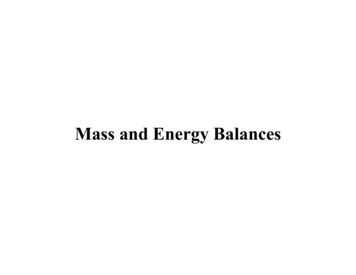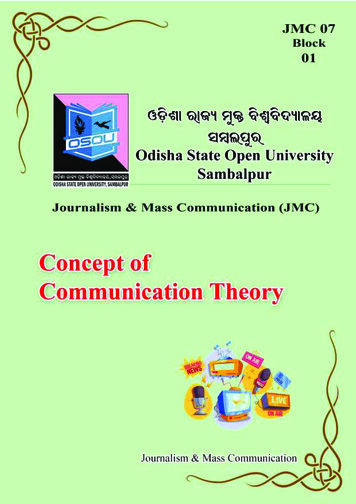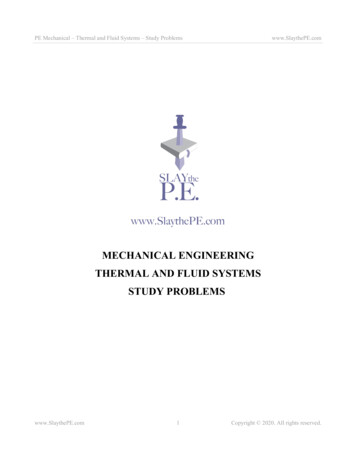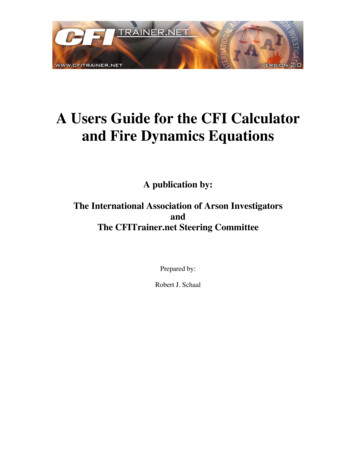
Transcription
Mass and Energy Balances
Outline Terminology– Specific heat, enthalpy, heat, sensible heat, latent heat, saturationtemperature & pressure, saturated liquid & vapor Phase diagram of water (liquid and vapor phases)– Sub-cooled liquid, condensate, steam (saturated steam: mix ofcondensate & vapor), vapor, superheated steam Steam tableSteam qualitySuperheated steamEnergy content (or enthalpy)– Liquid products, steam Mass and energy balances– Batch & continuous processes (mixing & heating); direct & indirectcontact heating; indirect contact cooling; determination of steam quality
Terminology Specific heat (cp: J/kg K)– Energy required to raise the temperature of unit mass of asubstance by unit value– It varies with temperature; however, for approximate calculations,cp of water is assumed to be 4180 J/kg K Enthalpy (H: J/kg)– Heat content of a system It is always expressed relative to a reference state (usually 0 C)– Generally, enthalpy is assumed to be zero at 0 C– For most liquids, H cp (Tin C) Heat (Q: J)– Energy transferred due to temperature difference between systemand surroundings When energy transferred is represented per unit time, its units are J/s or W The energy transferred may be utilized as sensible heat or latent heat
Terminology (contd.) Sensible heat (Q: J or J/s)– Energy transferred from hot to cold object For a batch system: Q m cp T. For a continuous system: Q m cp TQ is in JQ is in J/s or W Latent heat (Q: J or J/s)– Energy transferred during phase change without any temperature change For a batch system: Q m . For a continuous system: Q m Q is in JQ is in J/s or W Latent heat of vaporization ( vap: J/kg)– Energy reqd to convert 1 kg of a liquid to vapor phase w/o temperature change– It equals energy released when vapor condenses to liquid at that temperature For heating foods, the energy of condensing steam is made use of– Latent heat of vaporization of water at 100 C 2257.06 kJ/kg Latent heat of fusion ( fus: J/kg)– Energy required to convert 1 kg of a solid to liquid phase w/o temperature change Latent heat of fusion of ice at 0 C 333.2 kJ/kg
Terminology (contd.) Saturation temperature and pressure– Any substance can exist in more than one phase at one time For any pressure, there is a temperature at which a liquid can coexist withthe vapor phase This pressure and the corresponding temperature are called the saturationpressure and saturation temperature respectively Example: Water at 101.3 kPa (atmospheric pressure) has a saturationtemperature of 100 C. At higher pressure, saturation temperature is higher. Saturated liquid and saturated vapor– When only liquid phase exists at the saturation pressure andtemperature, the liquid is called saturated liquid or condensate (itsenthalpy is denoted by Hc)– When only vapor exists at the saturation pressure and temperature,the vapor is called saturated vapor (its enthalpy is denoted by Hv)
PressurePhase Diagram of WaterSubcooledliqLiq. Vap.Liq.Saturated steamWithin the dome,water exists as steam,which is a mixture ofliquid and vapor.Vap.Here, temperatureSuperheated steam and pressure areconstant and arecalled the saturationtemperature andpressure respectively.Left of dome: Subcooled liq; Within dome: Saturated steam; Right of dome: Superheated steamAs we move from left to right within the dome, more and more of thewater is in vapor phase. The fraction that is in vapor phase is calledsteam quality (denoted by ‘x’). It varies from 0 to 1 OR 0% to 100%.Latent heat of vap. ( vap) at any temp. or pr. Hv – Hcat that temp. or pr.
Saturated Steam TableTemperature( C)361.3What is the latent heat of vaporization of water at atmospheric pressure? vap (at atm. Pr.) Hv (at atm Pr.) – Hc (at atm. Pr.) 2676.1 – 419.04 2257.06 kJ/kg
Steam Quality (x) The term “Steam” generally refers to saturated steam and notsuperheated steam “Steam” is a mixture of liquid (condensate) and vapor The enthalpy of steam (Hs) is a weighted mean of enthalpy ofcondensate (Hc) and enthalpy of vapor (Hv) Hs x Hv (1 – x) Hc Rearranging,x (Hs – Hc)/(Hv – Hc) Note thatx 0 when Hs Hc Also,x 1 when Hs Hv Higher the steam quality, higher the value of Hs 0 x 1OR0% x 100%Note: Hc & Hv at saturation temperature & pressure are determinedfrom steam tables
Superheated Steam When the temperature of vapor is greater than thesaturation temperature (at its saturation pressure), thesteam is referred to as superheated steam The difference between steam temperature andsaturation temperature is the degree of superheat Superheated steam at a given pressure can havedifferent temperatures greater than the saturationtemperature (unlike saturated steam) Thus, to define the state of superheated steam, one hasto specify the temperature and pressure– To define the state of saturated steam one has to specifyeither temperature or pressure
Q versus TT (Temperature in C)1000S: Solid (ice)L: Liquid (water)V: Vapor (superheated steam)L V: Saturated steamL to VVLatentLSS to LLatentQ1Q1 fusion(ice) 333.2 kJ/kgQ2 cp(water) T 419.04 kJ/kgQ3 vap(water) 2257.06 kJ/kgQ3Q2Q (Energy Supplied)
Energy Content Thermal energy content of a solid or liquid:OR m cp (TCelsius - 0)m cp (TKelvin - 273) This is based on the assumption that the energy content ofthe substance is zero at 0 C ( 273 K) Thermal energy content (or enthalpy) of steam is given by:ms (Hs)Note: Hs x (Hv) (1 - x) Hc
Heat Exchanger (HX) Equipment where heat is exchanged between two products– Steam losing heat and cold product gaining heat– Hot water losing heat and cold product gaining heat– Cold water gaining heat and hot product losing heat They may be batch or continuous & direct or indirect contact Batch heating: Home microwave oven Continuous heating: Pumping a product through a tube andheating it by steam or hot water from outside Direct contact heat exchanger– Batch heating: Mixing steam with milk in the making of cappuccino– Continuous heating: Steam injection/infusion for a flowing product Indirect contact heat exchanger– Batch heating: Retorts (for canning)– Continuous heating: Retorts (canning), double tube, plate, shell & tube
Direct and Indirect Contact Heat Exchanger Direct contact heat exchanger– Steam contacts product and mixes with it– Steam loses energy as it condenses; product gains energy– Rapid heat transfer; however, product is diluted Vacuum may be used to remove added water Indirect contact heat exchanger (eg. concentric metal pipes)– Steam is separated from product by a barrier (metal pipe) Not as much or as rapid heating; however, product is not diluted Energy transferred by steam to a product in a direct contactheat exchanger is given by:ms (Hs) Energy transferred by steam (when steam condensescompletely) to a product in an indirect contact heatexchanger is given by:ms (Hs - Hc)
Mass Balance Overall mass balance– For any system, the total mass going into the system must equalthe total mass coming out of the system plus any accumulation ofmass in the system Batch system: mass (m) in kg. Continuous system: mass flow rate (m) in kg/s Component mass balance– For any component in a system, the total mass of that componentgoing into the system must equal the total mass of that componentcoming out of the system plus any accumulation of that componentin the system For any system (or sub-system), the number of mass balanceequations the number of components in the product– One mass balance equation can be written for each component
Energy Balance Energy balance– For any system, the energy going into the system must equal theenergy coming out of the system plus any accumulation of energyin the system Only ONE energy balance equation is written for anysystem (or sub-system) irrespective of the number ofcomponents in the product(s)Note: Once mass and energy balance equations are written, make surethat the number of equations and number of unknowns are equal
Applications of Mass and Energy Balance Mixing and/or separation of streams of products withdifferent compositions Condensation of steam outside a tube through whichproduct flows (indirect contact heating) Mixing of steam with a product (direct contact heating)– Direct contact heating is faster than indirect contact heating– Side-effect of direct contact heating is dilution of product Vacuum may be used to evaporate water that was added Evaporation of water from a product to concentrate itNote: For batch systems, the term “mass” (m) is used and for continuous.m: kg/ssystems, the term “mass flow rate” (m) is used m: kg
Mixing of Two Products in a Batch System(at the same temperature)m1, x1Mixerm2, x2The overall mass balance equation is :The total solids balance equation is :The total water balance equation is :m3, x3m1, m2, m3: Total massesx1, x2, x3: Solid fractionsm1 m2 m3m1 x1 m2 x2 m3 x3m1 (1-x1) m2 (1-x2) m3 (1-x3)The total water balance equation is however NOT a totally new equation. It can beobtained by subtracting the total solids balance equation from the overall mass balanceequation. Thus, there are only TWO equations for the above system. Hence, given any 4variables in the system, the other 2 variables can be determined (Note that the 6variables in the above system are m1, m2, m3, x1, x2, x3). Also note that in a system suchas the one shown above, x1 x2 x3
Mixing of Two Products in a Batch System(at different temperatures)m1, x1Mixercp(3), T3m3, x3cp(1), T1m1, m2, m3: Total massesx1, x2, x3: Solid fractionscp(2), T2 m2, x2cp(1), cp(2), cp(3): Specific heatsT1, T2, T3: TemperaturesMass balance equations are the same as beforeEnergy balance (when temperatures are in Kelvin):m1 {cp(1)}(T1 - 273) m2 {cp(2)} (T2 - 273) m3 {cp(3)} (T3 - 273)Energy balance (when temperatures are in Celsius):m1 {cp(1)}(T1) m2 {cp(2)} (T2) m3 {cp(3)} (T3)cp(1) x1 cp(s) (1 – x1) cp(w)cp(2) x2 cp(s) (1 – x2) cp(w)cp(3) x3 cp(s) (1 – x3) cp(w)cp(s): Specific heat of solidscp(w): Specific heat of water
Direct Heating with Steam (Continuous System).mf, xf, cp(f), TfDirect contact HXCold product.mp, xp, cp(p), TpWarm diluted productSteam.ms, quality of xPressure, P OR Temperature, T.m, x, cp, T: Mass flow rate, solids fraction, specific heat, temperature resp.Subscripts: ‘f’ for feed; ‘p’ for product.Overall mass balance: mf ms mp.Solids balance: mf xf mp xp.Energy balance: mf {cp(f)} Tf ms (Hs) mp {cp(p)} TpHs (x) Hv (1 – x) Hcwith Hv and Hc being determined from steam tablesat the steam pressure of P or steam temperature of T
Determination of Steam Qualityms, quality of x; Pressure, P OR Temperature, TSteammc, cp(c), TcCold waterFlaskmh, cp(h), ThHot waterm, cp, T: Mass, specificheat, temperature resp.Subscripts: ‘c’ for cold;‘h’ for hotIntroduce cold water of known mass (mc) and temperature (Tc) in a flaskIntroduce steam into flask till water becomes hot (Th)Determine specific heat of water at Tc and Th from table of properties of waterMass balance: mc ms mhEnergy balance: mc {cp(c)} Tc ms (Hs) mh {cp(h)} ThDetermine Hs from above equationUse interpolation for:Also, Hs (x) Hv (1 – x) Hccp(c), cp(h), Hc, Hvwith Hv and Hc being determined from steam tablesat the absolute (not gauge) steam pressure of P or steam temperature of TThus, x (Hs – Hc)/(Hv – Hc)
Indirect Heating with Steam (Continuous System).mf, xf, cp(f), TfCold productIndirect contact HX.mp, xp, cp(p), TpWarm undiluted product.ms, quality of xSteam100% CondensatePressure, P OR Temperature, T.m, x, cp, T: Mass flow rate, solids fraction, specific heat, temperature resp.Subscripts: ‘f’ for feed; ‘p’ for product.Overall mass balance: mf mp.Solids balance: mf xf mp xpThus, xp xf.Energy balance: mf {cp(f)} Tf ms (Hs) mp {cp(p)} Tp ms (Hc)Hs (x) Hv (1 – x) Hcwith Hv and Hc being determined from steam tablesat the absolute (not gauge) steam pressure of P or steam temperature of T
Indirect Cooling with Water (Continuous System).mf, xf, cp(f), Tf.mp, xp, cp(p), TpIndirect contact CoolerHot feedCold productT1Cold .watermcwT2.m, x, cp, T: Mass flow rate, solids fraction, specific heat, temperature resp.Subscripts: ‘f’ for feed; ‘p’ for product; ‘1’ for inlet water; ‘2’ for outlet water.Overall mass balance: mf mp.Solids balance: mf xf mp xpThus, xp xf.Energy balance: mf {cp(f)} Tf mcw{cp(1)}T1 mcw{cp(2)}T2 mp {cp(p)}Tpcp(1) and cp(2) are determined from tables containing the properties ofwater at temperatures T1 and T2 respectively.When approximations are used, cp(1) cp(2) 4180 J/kg K
Summary Energy of liquid: m cp TCelsius; Energy of steam: ms Hs Saturated steam tables– Enthalpy of condensate (Hc) and vapor (Hv) at various saturation T & P Steam quality: A measure of the amount of steam in vapor form It ranges from 0.0 to 1.0 OR 0% to 100% Calculations for direct heating using steam– Overall mass balance Steam is a part of the overall mass balance equation– Energy balance No need to factor the energy of steam on RHS of equation Calculations for indirect heating using steam– Overall mass balance Steam is NOT a part of the overall mass balance equation– Energy balance Energy of steam as it exits the system has to be included on RHS of equation
steam is referred to as superheated steam The difference between steam temperature and saturation temperature is the degree of superheat Superheated steam at a given pressure can have different temperatures greater than the saturation temperature (unlike saturated steam) Thus, to define










